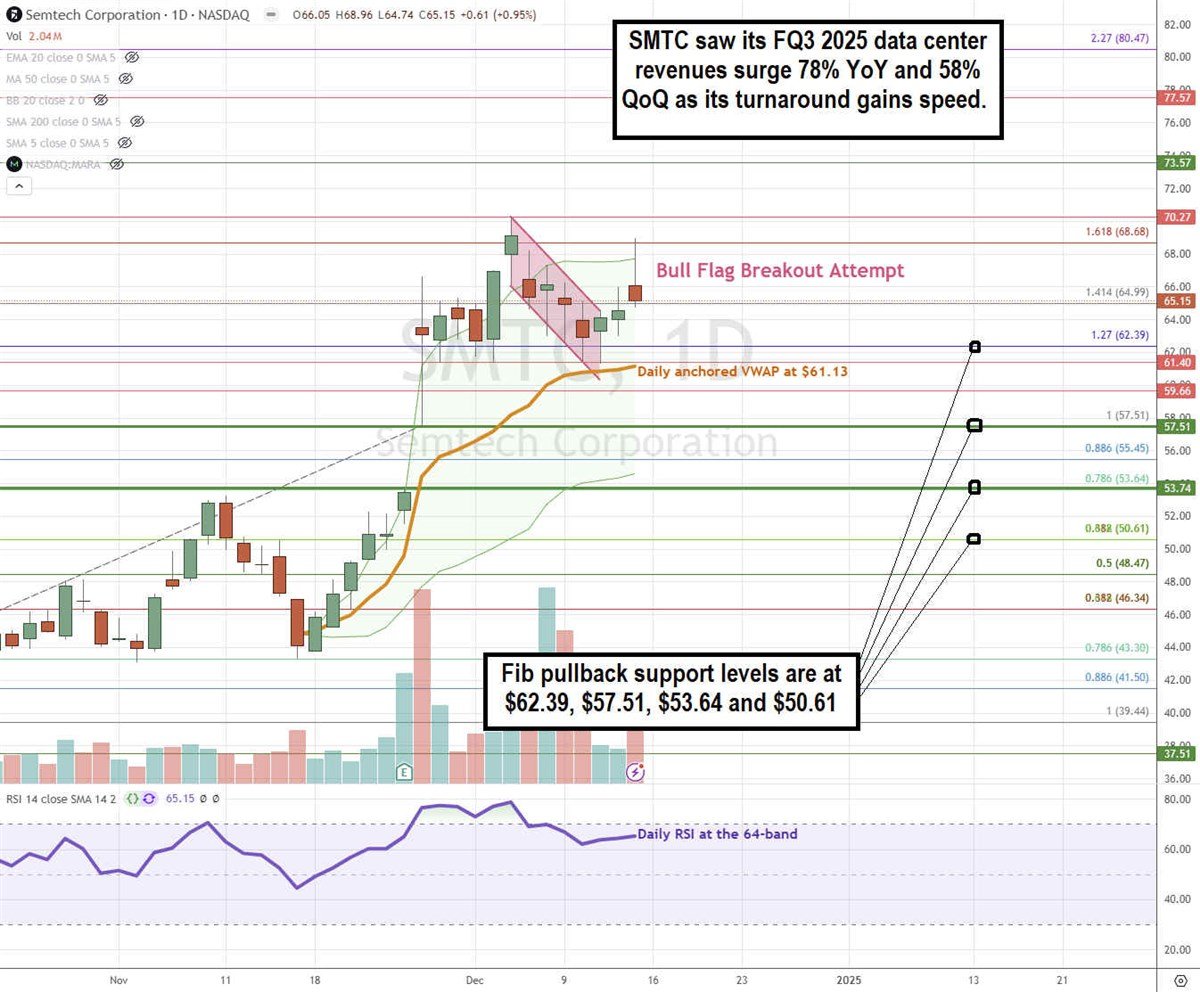Ticker Reports for December 16th
Semtech Stock Climbs as AI Boom Drives Turnaround Success
Semtech Co. (NASDAQ: SMTC) makes analog and mixed-signal chips that enable optical data transmission, sensing, and advanced high-speed connectivity solutions. Its products are used in consumer electronics, infrastructure, industrial applications, data centers, and Internet of Things (IoT) systems. The company’s turnaround is impressive as its revenue has returned to growth since its fiscal first quarter of 2025, with its recent FQ3 YoY revenues rising 18%. The computer and technology sector company supplies its products to Apple Inc. (NASDAQ: AAPL), Amazon.com Inc. (NASDAQ: AMZN), QUALCOMM Inc. (NASDAQ: QCOM) and Intel Co. (NASDAQ: INTC).
Semtech is benefiting from the robust demand in artificial intelligence (AI) applications, data centers, and IoT, which is driving its turnaround despite tough competition from the likes of Texas Instruments Inc. (NASDAQ: TXN), Broadcom Inc. (NASDAQ: AVGO) and Microchip Technology Inc. (NASDAQ: MCHP).
The Turnaround Is Underway as Semtech Returns to Growth in FQ3
Semtech's revenues have been on a steady rise since bottoming in its FQ1 2025, down 13% YoY, followed by FQ2, improving to down 10% YoY. FQ3 was the inflection quarter as revenues turned positive, growing 18% YoY, with Q4 estimates pointing at 30% YoY growth. Its FQ3 EPS beat consensus estimates by 3 cents, coming in at 23 cents. Its revenue rose 18% YoY and 10% sequentially to $236.8 million, nicely beating consensus estimates for $232.89 million. Data center revenue surged 78% YoY and 58% sequentially to a record $43.1 million. Non-GAAP gross margin grew 200 bps to 52.4%. Non-GAAP operating margin rose 410 bps to 18.3%.
Revenue Breakdown by End Market and Segment
The majority of FQ3 revenue, or 53% at $131 million, was derived from the Industrial end market, which includes IoT, radio frequency industrial, circuit protection, and long-range (Lo-Ra) enabled solutions. The Infrastructure end market generated 28% or $65.8 million in revenue, representing the data center revenues and shipments of its CopperEdge used in 1.6T active cable copper.
The High-End Consumer end market generated 17% of total revenue or $40 million. These revenues include consumer circuit protection and PerSe proximity sensing solutions. Analog mixed signal and wireless and IoT systems and connectivity segments generated 35% of revenues each, and signal integrity generated 30% in FQ3 2025.
Semtech Guides Higher FQ4 Top and Bottom Line Forecasts
The company issued upside EPS of 29 cents to 35 cents for the fiscal fourth quarter of 2025 versus 27 cents consensus estimates. Semtech forecasts revenues of $245 million to $255 million versus $242.03 million consensus estimates. Non-GAAP gross margin is expected between 52.3 and 53.3% and non-GAAP operating margin between 19% to 20.4%.
Semtech CEO Hong Hu was upbeat, commenting, "We are very pleased to report broad-based growth across each of our end markets, and particularly in the data center, where we project AI-driven product demand to be a long-term and transformational growth engine for Semtech. Our results validate that our customers and target markets are moving toward us and highlight the effectiveness of our initiatives to drive market share gain and SAM expansion."
SMTC Attempts a Bull Flag Breakout
A bull flag pattern is comprised of two parts. First, the underlying stock forms the flagpole, which is a steep run-up in the stock price, usually at a 45-degree or higher angle. The flagpole completes when the stock forms its peak. The flag is formed on the parallel descending trendlines comprised of lower highs and lower lows. The bull flag triggers when the stock surges through its upper descending trendline and past the peak of the flagpole.

SMTC surged on a gap to $70.27 on its FQ3 2025 earnings release to complete the flagpole. The parallel descending trendlines formed the flag, which bottomed at $61.40. The bull flag attempt triggered the breakout through $64.99, but the 0.618 Fib resistance at $68.68 capped its bounce. SMTC will need to break through the flagpole peak at $70.27 to complete the bull flag breakout. The daily anchored VWAP is slowly rising at $61.13. The daily RSI is flat at the 64-band. Fibonacci (Fib) pullback support levels are at $62.39, $57.61, $53.64, and $50.61.
SMTC’s average consensus price target is $68.70, implying a 5.45% upside and its highest analyst price target sits at $85.00. Ten analysts rate the stock as a Buy, while two assign a Hold rating. The stock has a 9.71% short interest.
Actionable Options Strategies: Bullish investors can consider using cash-secured puts at the Fib pullback support levels to buy the dip on SMTC. If assigned the shares, writing covered calls at upside Fib levels executes a wheel strategy for income.
"Fed Proof" Your Bank Account with THESE 4 Simple Steps
Starting as soon as a few months from now, the United States government will make a sweeping change to bank accounts nationwide.
It will give them unprecedented powers to control your bank account.
3 Companies Leading the Way With Aggressive Stock Buybacks
When companies are deemed cheap by insiders, management, in this case, applies a few simple strategies to the underlying stock so that investors regain confidence and an optimistic view of the name. Consequently, these same decisions help Wall Street analysts get behind the stock and potentially boost its price targets accordingly.
That standard method offers a higher dividend payout so that when compared to the stock price, the yields seem higher and more attractive for capital to flow in. There is one issue with this, though: It’s not the most efficient way to create shareholder value, as dividends are then taxed twice and take away from enterprise value since they are essentially capital leaving the company.
Stock buybacks are a better way to boost investor confidence and create more value at the same time. When management buys back stock, it sends a message to the markets and investors that the stock is considered cheap and expected to go higher soon. Knowing this, investors should be aware that companies like Etsy Inc. (NASDAQ: ETSY), Kroger Co. (NYSE: KR), and even Marathon Petroleum Co. (NYSE: MPC) are buying aggressively today.
How Inflation and Trade Trends Are Driving Etsy's Stock Buyback Strategy
Now that analysts at Morgan Stanley have become bearish on the United States dollar, a few repercussions might follow. First, a weaker currency will give foreign buyers additional buying power but also reduce domestic consumer buying power. This is where stocks like Etsy come into play, as they connect buyers and sellers globally.
Its scale and global reach will come in handy when consumers need foreign alternatives to find the products they need in an international trade environment that could be about to shift on currency swings. This is why management is getting ahead of the curb by approving a stock buyback program of just over $1 billion.
Now that the stock trades at 66% of its 52-week high, it makes sense for insiders to start backing the potential new trend to get the company back to its former glory. As bullish as this is, insiders aren’t the only ones willing to make their optimistic outlooks public on Etsy stock. Analysts at Truist Financial now have a $70 a share price target for Etsy and a Buy rating as well.
To meet these targets, the stock would have to stage a rally of up to 19% from where it trades today and still be significantly below its 52-week high. More than that, as of November 2024, institutional investors from Pacer Advisors decided to boost their holdings in Etsy stock by 183.9% to bring their net position to a high of $331 million.
Why Kroger Is Buying Back Stock as Defensive Stocks Regain Appeal
Following the same domestic and global trade trend, backed by Morgan Stanley’s view on the dollar, investors can see how Kroger stock might become attractive in this environment. As part of the consumer staples sector, its defensive and non-cyclical nature could be invaluable to portfolios.
This time, momentum has already favored the stock, as it trades at its 52-week high. However, that didn’t stop management from still approving a $7.5 billion stock buyback program to give investors an idea of where it could be headed in the coming quarters. Wall Street analysts know this, too, and they aren’t afraid of pushing for higher prices.
Particularly those at Wells Fargo, who, as of December 2024, reiterated an Overweight rating for Kroger stock, this time with a price target of up to $73 a share. To prove these new valuations right, the stock would have to rally by as much as 18% from where it trades today, giving investors another double-digit upside option in this list.
Like Etsy, institutions saw enough reasons to start buying the stock alongside management.
State Street boosted its Kroger stock holdings by 16% as of November 2024, netting their position at $1.9 billion, or 4.6% ownership in the company, to give investors another optimistic gauge to consider for their buy cases.
New Business Activity Is Good For Oil and Marathon Petroleum Stock
After contracting for 25 consecutive months, the manufacturing PMI index could see a sharp rebound if Morgan Stanley analysts are right about the dollar's bearish outlook.
As exports are stimulated by the lower dollar, production and transport need to kick up to fulfill these new orders.
And that all need oil to happen, which might be the same view Warren Buffett took when he bought up to 29% of Occidental Petroleum Co. (NYSE: OXY) or when Marathon Petroleum approved an up to $5 billion stock buyback program.
As oil prices remain at $70 a barrel, energy stocks become attractive buys.
But here’s why Marathon is one of the best buys in the industry.
Wall Street analysts are now projecting up to $7.48 in earnings per share (EPS) for the first quarter of 2025, a growth rate of nearly tenfold unseen anywhere else in the peer group.
From these projections, those at Wells Fargo felt confident enough to boost the stock to $186 a share, calling for a net rally of up to 30% from where the stock trades today.
WARNING: "Buffett Indicator" flashing for first time in 50 years
Warren Buffett has sold a staggering $97 billion worth of stocks this year...
But why?
Our research indicates the Oracle of Omaha is quietly preparing for a historic market crash.
His most reliable crash indicator - the "Buffett indicator" - just flashed red for the first time in 25 years.
Is It Time to Buy Nuclear Energy Stocks After the Latest Dip?
The utilities sector, represented by the Utilities Select Sector SPDR ETF (NYSE: XLU), has been experiencing turbulence, pulling back nearly 7% from its 52-week high since the start of December. This decline marks a sharp reversal from its prior outperformance, as capital flows have rotated out of the sector. Over the past three months, the XLU ETF reported net outflows of 6.28%, signaling a shift in investor sentiment.
Previously, the utilities sector benefitted from tailwinds like Federal Reserve rate cuts and rising energy demand fueled by the growing adoption of electric vehicles. However, the resurgence of nuclear energy played an outsized role in the sector's recent momentum. With increasing demand projected from artificial intelligence (AI) and data centers, nuclear energy has been positioned as a critical component of the future of clean energy, drawing substantial investor interest.
Amid this wave of enthusiasm, several nuclear-focused stocks soared to impressive heights. One standout, Vistra Corp (NYSE: VST), emerged as the top-performing S&P 500 stock by November. However, following a recent pullback, VST has ceded its position to Palantir Technologies (NYSE: PLTR). With Vistra and other key players retreating alongside the broader sector, could this dip present an opportunity to gain exposure to nuclear energy stocks? Let’s dive into the details.
Vistra Corp: A Clear Industry Leader
Despite a 14% retreat from its 52-week high, Vistra remains one of the best-performing S&P 500 stocks year-to-date, boasting a remarkable 276% gain. The company is uniquely positioned to capitalize on AI-driven electricity demands, operating 41,000 megawatts (MW) of generation capacity, including 6,400 MW of nuclear power. It also holds the second-largest energy storage capacity in the U.S., a critical asset for balancing energy supply and demand in the AI era.
Financially, Vistra appears attractively valued after its pullback. The stock trades at a price-to-earnings (P/E) ratio of 27.4 and a forward P/E of 20.8, approaching benchmarks that could signify a bargain for value investors. Its price-to-sales (P/S) ratio stands at 3.2, with projected earnings-per-share (EPS) growth of nearly 40% in 2024.
Recent earnings, reported in November, showed a 25% revenue estimate beat to $6.28 billion, although EPS narrowly missed analyst estimates by 3%. Sales have increased year-over-year by 53.9% in the last reported quarter and 54% in the third quarter of 2024. Notably, the company’s cash flow growth of 261% far exceeds the industry average of 6.3%. Historically, its annualized cash flow growth rate of 17.8% over the past 3–5 years surpasses the sector’s average of 6.1%.
From a technical perspective, Vistra’s stock is approaching critical support near $140, coinciding with its rising 50-day simple moving average (SMA). This level could serve as a favorable risk-to-reward entry point for investors. However, if this support breaks amid continued sector weakness, the next significant level lies near $120. Analysts remain bullish on the stock, with all ten Wall Street analysts covering it issuing a Buy rating. The consensus price target suggests a modest 3% upside from current levels, reflecting confidence in the company’s potential even after its stellar 2024 performance.
Speculative Bets on Nuclear Innovation
While Vistra offers stability and proven growth, smaller nuclear energy stocks have drawn attention for their groundbreaking innovations and speculative appeal.
Companies like NuScale Power Corporation (NYSE: SMR), Oklo Inc. (NYSE: OKLO), and Nano Nuclear Energy Inc. (NASDAQ: NNE) are pushing the boundaries of nuclear technology.
NuScale leads in advanced small modular reactors (SMRs), offering a compact, scalable alternative to traditional reactors.
Oklo focuses on fast fission reactors for clean energy, while Nano Nuclear specializes in microreactor technologies, including the ZEUS solid-core battery reactor.
These mid-cap companies are largely pre-revenue and heavily reliant on raising additional capital to meet operational goals.
As a result, their stock prices are significantly more volatile than established players like Vistra.
All three have pulled back over 30% from their recent highs, reflecting the risks associated with their speculative nature.
These stocks could be appealing for investors willing to embrace higher risk in exchange for potentially outsized rewards. However, they require a long-term horizon and a strong tolerance for volatility.






0 Response to "🌟 Semtech Stock Climbs as AI Boom Drives Turnaround Success"
Post a Comment